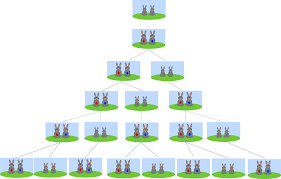The golden ratio also known as the golden number and the divine proportion is symbolized with the Greek letter φ. It can be found in a lot of different domains like mathematics, nature, astrology, architecture…
Mathematically, two quantities a and b, with a>b>0, are in the golden ratio if they validate this equation : (a+b)/a=a/b= φ

The relation between the segments a and b is the same than the relation between the segments a+b and a.
The golden ratio is equal to 1,61803… it’s an irrational number, the digits keep on going with no pattern.
In mathematics, numbers form a sequence called Fibonacci sequence when each number is the sum of the two preceding ones. Starting with 0 and 1 : 0 1 1 2 3 5 8 13 21…
Fibonacci numbers are strongly related to the golden ratio, in fact when you calculate the ratio of two consecutive numbers it tends to the golden ratio’s value. And as the values of the sequence increase the closer the result is to the golden number. 8/5=1,6 13/8=1,625 21/13=1,615…
So what is the link with the expansion of pairs of rabbits you still wonder ?
Let’s start off with 1 couple of rabbits. They will need 1 month to mature and be able to produce another couple of young rabbits.

In January, we start off with a young couple of rabbits (a).
In February, the couple (a) matures and breeds.
In March, we still have the first couple (a) and a new young couple (b).
In April, there is a new couple of young rabbits ( c) born from the couple (a) and the couple (b) now matured.
In May, the couples (a) and (b) made young couples (d) and (e) and couple ( c) matured.
And so on.
So do you see it now ?
With no deaths, each month the number of couples is the next number in the Fibonacci series : 1 1 2 3 5 8 …
The Fibonacci sequence can also be found in the nature, like in the way some plants grow. Have you ever had a close look at sunflower seeds. If you pay enough attention you can notice that the seeds are positioned in a way that they form 2 spirals going in opposite directions.

In yellow there’s 21 branches forming the first spiral and in red, 34 branches forming the second spiral turning in the opposite way. These numbers are part of the Fibonacci sequence. It is explained by the fact that the plant needs to grow his seeds in the most efficient way possible, so no space is wasted and the seeds have the maximum room to flourish. This pattern is based on the Golden Ratio.
This phenomenon can also be found in pine cones and many other flowers. So next time you go on a walk keep an open eye and you might be able to see approximations of the golden ratio !
-by Melainie
https://www.mathsisfun.com/numbers/golden-ratio.html

